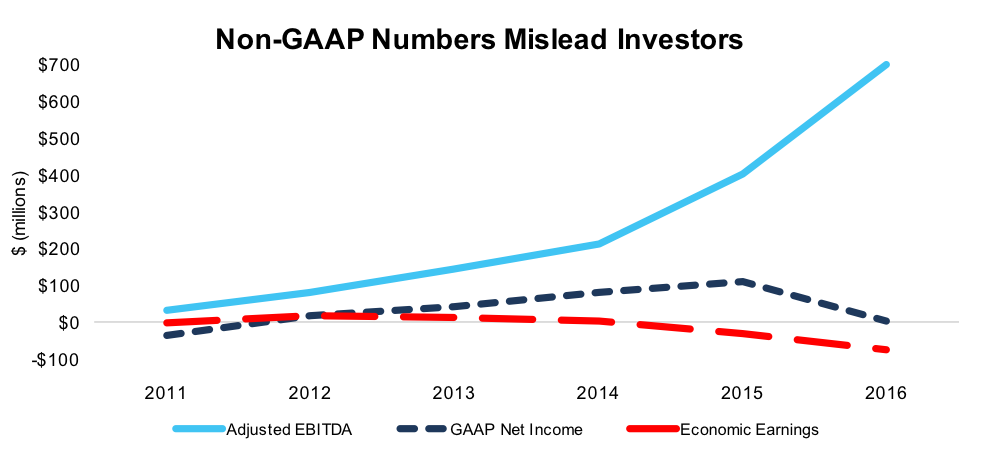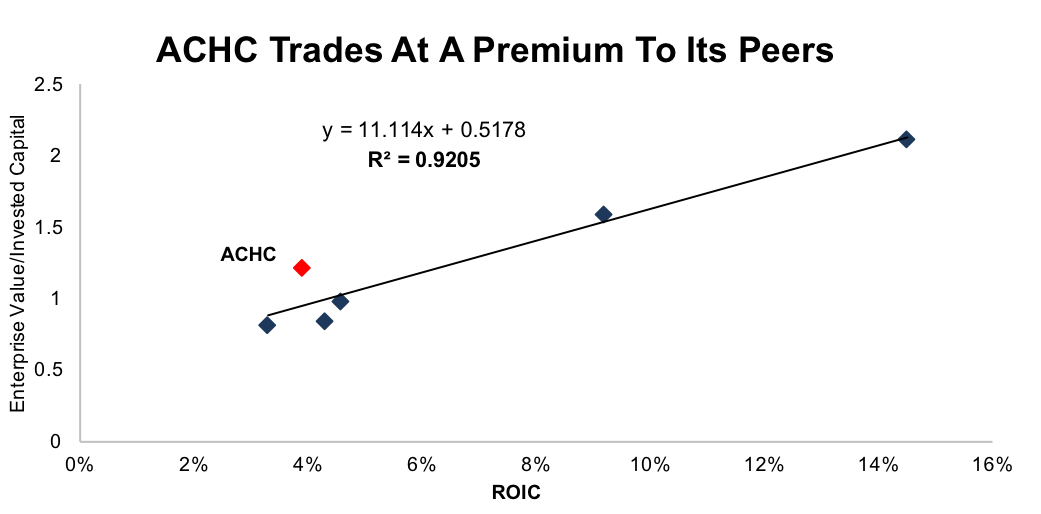We put behavioral healthcare provider Acadia Healthcare Company (NASDAQ:ACHC) in the Danger Zone just over a year ago, and the stock has been on a wild ride since. The stock plummeted nearly 40% in the second half of 2016 on the back of disappointing earnings and regulatory concerns over its acquisition of Priory Group. Most of that decline has been reversed in 2017 due, in large part, to political developments.
Overall, the stock is down roughly 4% since our original report against a 14% gain for the S&P 500. Despite the company touting its impressive non-GAAP numbers, the stock is just as dangerous as ever.
Non-GAAP Numbers Mislead Investors
Acadia and other companies that pursue a roll-up strategy often benefit from the confusion and opacity surrounding their financial statements. Acquisitions create unusual, non-recurring expenses that distort GAAP net income, which companies like to use as justification for touting their own non-GAAP metrics instead.
For Acadia, “Adjusted EBITDA” is the non-GAAP number to which they point investors. Here’s a helpful hint: if a company talks about Adjusted EBITDA, run. The metric is a favorite of roll-up schemes such as Verint Systems Inc (NASDAQ:VRNT) and Valeant Pharmaceuticals (NYSE:VRX) as well as highly unprofitable companies like Snap (NYSE:SNAP) and Pandora (NYSE:P).
Adjusted EBITDA lets companies ignore all the capital costs involved in acquisitions (for which they often over pay) and throw out real operating costs such as stock compensation while they’re at it. Figure 1 shows just how much Acadia’s Adjusted EBITDA diverges from GAAP earnings and economic earnings over the past few years.
Figure 1: Acadia’s Adjusted EBITDA Dramatically Overstates Profits

Source: New Constructs, LLC, and company filings
Exec Comp Plan Rewards Value Destruction
2016 saw Acadia report record profits on a non-GAAP basis even as the company destroyed record amounts of shareholder value with the $2.2 billion Priory Group acquisition.
As a result, executive compensation soared to new heights even as cash flows plummeted. CEO Joey Jacobs earned $9.4 million in 2016, his highest annual compensation on record, despite Acadia posting its worst ever economic earnings and the stock falling by 47%. As long as Acadia ties executive compensation to Adjusted EBITDA, its executives are incentivized to carry out expensive acquisitions that destroy shareholder value.
Roll-Up Strategy Still Isn’t Working
Acadia operates in the Behavioral Healthcare field, which focuses on treating people with mental illness and addiction. The industry is fairly fragmented, and the bull case for Acadia has rested on the idea that it can reap efficiency gains through consolidation.
As Figure 1 shows, the consolidation theory has not borne out. As Acadia has poured more money into acquisitions, it has failed to earn enough of a return on invested capital (ROIC) to generate positive economic earnings.
It should not be surprising that these acquisitions have failed to generate shareholder value. Behavioral healthcare is a highly-localized field, so the typical acquisition benefits of pricing power and economies of scale are largely absent. Acadia’s theory has been that it can create excess value at the facilities it acquires by improving patient care and expanding referral networks, but this strategy is not working.
In fact, Acadia continues to rank near the bottom of its peer group in terms of ROIC, per Figure 2. Longer-term Acadia’s ROIC has fallen from 9% in 2012 to the current bottom quintile 4% TTM.
Figure 2: Acadia’s ROIC Lags The Competition

Sources: New Constructs, LLC and company filings
Despite the poor track record, the company continues to pursue its acquisition-based strategy. On the latest earnings call, CEO Joey Jacobs told analysts, “We are continuing to actively evaluate additional acquisitions.”
Repeating Our Warning
All the negatives on ACHC that we articulated last July have only worsened. Management is doubling down on the failed strategy and misleading accounting practices that landed ACHC in the Danger Zone in the first place. The company’s non-GAAP Adjusted EBITDA has become even more misleading, its acquisition strategy more destructive, and its liabilities larger. Investors who heeded our first warning avoided a year of highly volatile underperformance. We recommend investors continue to avoid this stock. Anyone who owns it should take the gains from the past few months before they reverse.
Bull Case Dependent on Uncertain Political Situation
Much of ACHC’s gain so far in 2017 has been due to political developments. Investors breathed a sigh of relief after the Obamacare repeal bills that would have cut Medicaid – which makes up 25% of Acadia’s revenues – died in the Senate.
Meanwhile, the company has seen a spike in government support due to increased political attention to the opioid crisis. The company recently received $4 million in government funding through the 21st Century Cures Act, and many expect to see more money flowing to addiction treatment facilities in the near future.
While these are certainly welcome developments to ACHC investors, the market seems to have overreacted. Medicaid could still face cuts, and it’s unclear how much more money the government is willing to commit to combat opioid addiction. In addition, a good portion of the government money out there will likely be allocated to the large general hospital operators such as HCA.
Any company whose outlook depends heavily on government actions faces a high degree of risk, especially in a political climate as uncertain as ours.
ACHC is Overvalued Compared To Peers
Government regulatory risk might be worth taking if ACHC were cheaply valued, but it is not. The stock approached a reasonable valuation when it bottomed in early January, but today it is, again, highly overvalued.
Figure 3 shows ACHC and its peers compared on the basis of ROIC and enterprise value divided by invested capital (a cleaner version of price to book). As you can see, ROIC explains 92% of the difference in enterprise value divided by invested capital for these stocks.
Figure 3: ROIC Vs. Enterprise Value Per Invested Capital For Behavioral Healthcare Stocks

Sources: New Constructs, LLC and company filings
ACHC stands out as the major outlier in Figure 3, trading at a significant premium to its peers. The stock’s valuation implies that the market expects its ROIC to increase from the current 3.9% to 6.3%. Immediately achieving a 6.3% ROIC on current revenue and invested capital equates to an increase in NOPAT margin from 10% (TTM) to 16%. The average NOPAT margin for healthcare facilities operators in Figure 3 is 7%. As such, ACHC achieving the operational efficiency necessary to reach 16% NOPAT margin seems highly unlikely.
Our discounted cash flow model tells a similar story. In order to justify its current valuation of ~$51/share, ACHC would need to grow operating profit (NOPAT) at 7% compounded annually for 16 years at an average ROIC of nearly 6%. This expectation seems optimistic given ACHC’s history of shareholder value destruction.
Even if we assume ACHC could achieve 2016 NOPAT margins (10%) and grow NOPAT by 10% compounded annually for the next decade, the stock is worth only $34/share today – a 33% downside. This scenario also assumes the company is able to grow revenue and NOPAT without increasing working capital or investing in fixed assets. This assumption is unlikely given the firm’s acquisition history but allows us to create a very optimistic scenario. For reference, ACHC’s invested capital has grown on average $1.3 billion (47% of revenue) each year for the past five years.
Is ACHC Worth Acquiring?
The largest risk to our bear thesis is what we call “stupid money risk”, which means an acquirer comes in and pays a premium price despite ACHC stock being overvalued. Investors may hope that ACHC can avoid having to meet the lofty expectations embedded in its stock price by getting acquired by a larger competitor, but that outcome appears unlikely. We discussed the challenges facing any potential acquirer in our original Danger Zone report on ACHC, and those challenges have only grown.
In particular, the Priory acquisition added over $1 billion in debt to Acadia, bringing its debt total to $3.9 billion (87% of market cap), which includes $635 million (14% of market cap) in off-balance sheet debt. These liabilities could make a deal prohibitively expensive for any potential acquirer.
Insider Selling and High Short Interest Raises Red Flags
Some of Acadia’s directors seem to agree that the stock is overvalued. On July 31, just three days after executives touted the company’s Adjusted EBITDA growth on the 2Q earnings call, two members of the Board of Directors sold 3.6 million shares worth ~$190 million.
Over the past 12 months, ACHC insiders have sold 11.7 million shares and purchased 230 thousand, for a net impact of 11.5 million shares sold. These sales represent 13% of shares outstanding.
Additionally, there are 24.1 million shares sold short, or just over 27% of shares outstanding. Short interest at this level indicates we are far from alone in our assessment of ACHC.
Impact of Footnotes Adjustments and Forensic Accounting
Our Robo-Analyst technology enables us to perform forensic accounting with scale and provide the research needed to fulfill fiduciary duties. In order to derive the true recurring cash flows, an accurate invested capital, and a real shareholder value, we made the following adjustments to Acadia’s 2016 10-K:
Income Statement: we made $604 million of adjustments with a net effect of removing $285 million in non-operating expenses (10% of revenue). We removed $445 million related to non-operating expenses and $160 million related to non-operating income. See all adjustments made to ACHC’s income statement here.
Balance Sheet: we made $1.7 billion of adjustments to calculate invested capital with a net increase of $1 billion. The most notable adjustment was the $635 million in off-balance sheet debt referenced above. See all adjustments to ACHC’s balance sheet here.
Valuation: we made $4 billion of adjustments with a net effect of decreasing shareholder value by $4 billion. $3.9 billion (85% of market cap) of the decrease in value came from the removal of ACHC’s total debt, which includes the operating leases noted above.
Unattractive Funds That Hold ACHC
There following funds receive our Unattractive-or-worse rating and allocate significantly to ACHC.
- Century Small Cap Select Instl (CSMCX) –0% allocation and Unattractive rating.
- AMG TimesSquare All Cap Growth (MTGVX) – 2.0% allocation and Unattractive Rating.
Disclosure: David Trainer and Sam McBride receive no compensation to write about any specific stock, style, or theme.
